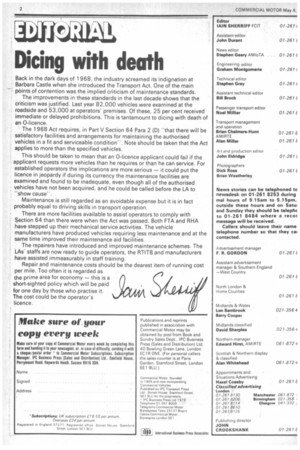Dicing with death
Page 4

If you've noticed an error in this article please click here to report it so we can fix it.
Back in the dark days of 1968, the industry screamed its indignation at Barbara Castle when she introduced the Transport Act. One of the main points of contention was the implied criticism of maintenance standards.
The improvements in these standards in the last decade shows that the criticism was justified. Last year 82,000 vehicles were examined at the roadside and 53,000 at operators' premises. Of these, 25 per cent received immediate or delayed prohibitions. This is tantamount to dicing with death of an 0-licence.
The 1968 Act requires, in Part V Section 64 Para 2 (D) "that there will be satisfactory facilities and arrangements for maintaining the authorised vehicles in a fit and serviceable condition". Note should be taken that the Act applies to more than the specified vehicles.
This should be taken to mean that an 0-licence applicant could fail if the applicant requests more vehicles than he requires or than he can service. For established operators the implications are more serious — it could put the licence in jeopardy if during its currency the maintenance facilities are examined and found to be inadequate, even though all of the authorised vehicles have not been acquired, and he could be called before the LA to "show cause".
Maintenance is still regarded as an avoidable expense but it is in fact probably equal to driving skills in transport operation.
There are more facilities available to assist operators to comply with Section 64 than there were when the Act was passed. Both ETA and RHA have stepped up their mechanical service activities. The vehicle manufacturers have produced vehicles requiring less maintenance and at the same time improved their maintenance aid facilities.
The repairers have introduced and improved maintenance schemes. The LAs" staffs are now ready to guide operators, the RTITB and manufacturers have assisted immeasurably in staff training.
Repair and maintenance costs should be the dearest item of running cost per mile. Too often it is regarded as the prime area for economy — this is a short-sighted policy which will be paid for one day by those who practise it. The cost could be the operator's licence.
























































































































